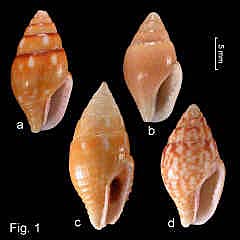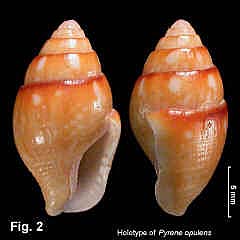|
|
|
|
|
Pyrene flava (Bruguière, 1789) Description: Eastern Australian shells solid, spire straight sided or convex, turreted, whorls rounded; aperture less than half shell length. Axial sculpture absent; spiral sculpture restricted to about 10 strong cords on base of body whorl. Outer lip of aperture sinuous with wide, shallow sinus posteriorly; thickened externally, and in the centre internally, with up to 10 denticles. Columella sharp-edged in mature shells, with 3-7 denticles. Anterior canal not upturned, siphonal notch shallow. Colour variable; generally fawn, usually with white spots; often a dark brown band below suture and widely-spaced large white spots below. Size: Eastern Australian shells up to 24 mm in length. Distribution: Tropical Indo-West Pacific. In Australia, North West Cape, WA, around northern Australia to Yamba, NSW. Habitat: Most NSW specimens are beach collected empty shells. Uncommon. Comparison: P. punctata is about the same size and also variable in colour. In P. punctata the spire is strongly convex, while in P. flava it is straight or moderately convex. Synonymy: Pyrene opulens Woolacott, 1957 is the colour form with a dark brown band below the suture and widely spaced white spots below (Fig. 2, holotype). Remarks: This species has a wide variation in shell shape and colour throughout its range in Australia. The shells shown here in Figs. 1 and 2 are from eastern Australia. Wilson (1994, pl. 16, figs. 17 a-f) illustrates, as P. flava, shells of a different species, Pyrene obscura (Soweby, 1844), that is larger and more elongate, and has a very different colour pattern. P. obscura is believed to be endemic to Western Australia. Fig. 1: a. Angourie, NSW. (C.373608) b. Clarence River, NSW. (C.373604) c. Broadhurst Reef, off Townsville, Queensland (C.373122) d. Alexandra Head, Queensland (C.242774) Fig. 2: HOLOTYPE of Pyrene opulens. Angourie, NSW (C.103284) |

